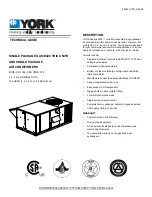
53
System Airflow Measurement
Much of the systems performance and reliability is closely
associated with, and dependent upon having the proper air-
flow supplied both to the space that is being conditioned
and across the evaporator coil.
With the supply fan rotating in the proper direction, measure
the amperage at the supply fan contactor. If the amperage
exceeds the motor nameplate value, the static pressure is
less than design and the airflow is too high. If the amperage
is below the motor nameplate value, static pressure may be
too high and CFM may be too low. To determine the actual
CFM (± 5%);
a. Measure the actual fan RPM
b. Calculate the Theoretical BHP
Actual Motor Amps X Motor HP)
Motor Nameplate Amps
c. Plot this data onto the appropriate Fan Performance
Curve or Performance Table that shipped with the Air
Handling equipment. Where the two points intersect,
read the CFM line.
Use this data to assist in calculating a new fan drive if the
CFM is not at design specifications.
An alternate method with less accuracy is to measure the
static pressure drop across the evaporator coil. This can be
accomplished by;
a. Drilling a small hole through the unit casing on each
side of the coil.
Note: Coil damage can occur if care is not taken
when drilling holes in this area.
b. Measure the difference between the pressures at
both locations.
c. Plot this value onto the appropriate component
pressure drop curve that shipped with the Air
Handling equipment. Use the data to assist in
calculating a new fan drive if the CFM is not at
design specifications.
d. Plug the holes after the proper CFM has been
established.
Turn the 115 volt control circuit switch 1S2 to the “OFF” po-
sition and open the field provided or optional factory
mounted disconnect switch.
After all adjustments have been made, proceed through the
following procedures.
Compressor Start-Up
(All Systems)
1. Before closing the field provided or optional factory
mounted disconnect switch at the unit, ensure that the
compressor discharge service valve and the liquid line
service valve for each circuit is back seated.
COMPRESSOR SERVICE VALVES!
COMPRESSOR SERVICE VALVES MUST BE FULLY
OPENED BEFORE START-UP (SUCTION, DIS-
CHARGE, LIQUID LINE, AND OIL LINE).
Failure to fully open valves prior to start-up may
cause compressor failure due to lack of refrigerant
and/or oil flow.
2. If the system has been previously charged before start-
ing, disable the compressor(s) by unplugging the reset
relay for each circuit. Refer to the unit-wiring diagram
that sipped with the unit. Turn the main power disconnect
to the “On” position and allow the crankcase heater to
operate a minimum of 8 hours before continuing.
Note: Compressor Damage could occur if the
crankcase heater is not allowed to operate the
minimum 8 hours before starting the
compressor(s).
3. Attach a set of service gauges onto the suction and dis-
charge gauge ports for each circuit.
4. Charge liquid refrigerant into the liquid line of each refrig-
erant circuit with the required amount of R-22. Refriger-
ant should be charged into the system by weight. Use an
accurate scale or a charging cylinder to monitor the
amount of refrigerant entering the system. Refer to Table
5-3 for the required amount of refrigerant for the system.
If the pressure within the system equalizes with the pres-
sure in the charging cylinder before charging is com-
pleted, complete the process by charging into the suction
(low) side of the system after the system has been
started.
Table 5-4 gives the minimum starting temperatures for
both “Standard” & “Low” Ambient units.
Do not attempt to charge the system with the low ambi-
ent dampers and/or hot gas bypass operating (if appli-
cable). Disable the low ambient dampers in the “Open”
position (refer to the “Low Ambient Damper Adjustment”
section) and de-energize the hot gas bypass solenoid
valves before proceeding.
5. On units with dual circuits, start only one circuit at a time.
To disable the compressors, unplug the appropriate lock-
out relay inside the unit control panel. Refer to Table 5-5
for the compressor sequencing and Figure 5-4 for their
location.
6. Close the “High Side” valve on the manifold gauge set.
7. Set the “System” selection switch to the “Cool” position
8. Turn the main power disconnect switch or circuit protec-
tor switch, to the unit, “On”.
System Start-Up (Continued)
Содержание RAUC-IOM-15
Страница 8: ...8 Figure 3 2A RAUC C80 Unit Dimensional Data Recommended Clearances...
Страница 9: ...9 Figure 3 2A Continued RAUC D10 Unit Dimensional Data Recommended Clearances...
Страница 10: ...10 Figure 3 2A Continued RAUC D12 Unit Dimensional Data Recommended Clearances...
Страница 11: ...11 Figure 3 2B EVPB C80 Evaporator Chiller Dimensions...
Страница 12: ...12 Figure 3 2B Continued EVPB D10 Evaporator Chiller Dimensions...
Страница 13: ...13 Figure 3 2B Continued EVPB D12 Evaporator Chiller Dimensions...
Страница 14: ...14 Figure 3 2B Continued EVPB C80 through D12 Chill Water Pipe Stubout Dimensions...
Страница 35: ...35 Installation Continued Field Connection Diagram Notes for all System Control Options...
Страница 57: ...57 Figure 5 5 Typical Scroll Compressor Terminal Block System Start Up Continued...
Страница 67: ...67...
Страница 68: ...68...
















































